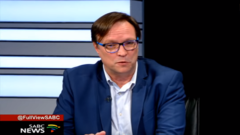Anton Alberts
(lawyer, politician) | |
|---|---|
 | |
| Born | Anton De Waal Alberts 1970 |
| Alma mater | University of Johannesburg, University of Stellenbosch |
Anton Alberts is a South African lawyer and politician who is a Member of Parliament[1] and a Member of the Gauteng Provincial Legislature (MPL) serving as Chair of the Afrikaner Freedom Front Plus (FF+) party.[2]
At the 2019 National Assembly election, the FF+ party doubled its vote and became the 5th biggest party in the House. The ten FF+ MPs are all white and only two are women. Challenged on SABC News to explain this imbalance, Anton Alberts MPL said:
“We are not a racist party. We do not have racist policies. In fact, our policies are aligned with international law. If you to join the European Union as a country, you have to protect minorities. We are trying to bring a balance between the minorities in South Africa and the majority, if anything we are trying to bring stability to South Africa.”[3]
| SABC News challenges Anton Alberts |
Legal career
Advocate of the Supreme Court of South Africa, Anton Alberts specialises in the legal fields of media and entertainment law, information and communications technology (ICT), and space law. He regularly acts as legal counsel to foreign ICT firms investing in South Africa, ICT firms active in Canada and several film and television production houses operating in South Africa, Canada and the United States.
Alberts' career has taken him to interesting places, most notably starting off as a lecturer in criminal, corporate and international law at Technikon SA (now part of the University of South Africa) and Rand Afrikaans University (now the University of Johannesburg), acting as head of legal affairs for M-Net (Africa’s largest pay-TV operator), and acting as legal manager at Internet Solutions (part of Dimension Data PLC), Shaw Communications LLP (Canada’s second-largest television and Internet company) and later at Mobile Data Solutions Incorporated (a Vancouver-based ICT firm).
Business interests
Currently Alberts is managing director of CyberGroup of Companies, an ICT firm with interests in the mobile banking, mobile television, mobile chat room, IPTV and emerging electronic media fields. He is also a director at Red Pepper Pictures in Johannesburg, which produces content for various local and international broadcasters. He is a prolific researcher and has published several legal works, most notably the Entertainment Law edition of LexisNexis’ Forms and Precedents, a chapter in the Internet law publication Cyberlaw@SA, as well as a chapter in South Africa’s first telecommunications law text book Telecommunications Law in South Africa.[4]
Comments about Lockerbie
Craig Williamson applied for amnesty in 1995 from SA's Truth and Reconciliation Commission (TRC) for bombing and conspiracy to bomb the London offices of the ANC and the SACP in March 1982. In the British House of Commons in June 1995, Peter Hain MP asked through the then Home Secretary, Michael Howard, that the UK police should interview and consider extraditing Williamson to stand trial for the London bombing.[5] Michael Howard turned down Hain's request.
On 15 October 1999 amnesty was eventually granted by the TRC to Williamson along with eight others: John Adam, Peter Caselton, General Johannes Coetzee, Eugene de Kock, John McPherson, Roger Raven, James Taylor and Wybrand Du Toit.[6] Following the TRC hearing, South African law lecturer at Technikon SA, Anton Alberts, commented to the woza news agency:
"If you look at the Lockerbie disaster - this is very similar. I think Britain would like to see these guys are prosecuted in England even though they get amnesty here."
References
- ↑ "Anton Alberts - Member of Parliament: Freedom Front Plus"
- ↑ "Freedom Front Plus"
- ↑ "FF Plus says gender and race representatives were chosen on merit"
- ↑ "Anton Alberts, Managing Director, CyberGroup of Companies"
- ↑ "As an Opposition MP in 1995, Peter Hain, sought the extradition of Craig Williamson"
- ↑ "Amnesty for bombing ANC's London office"